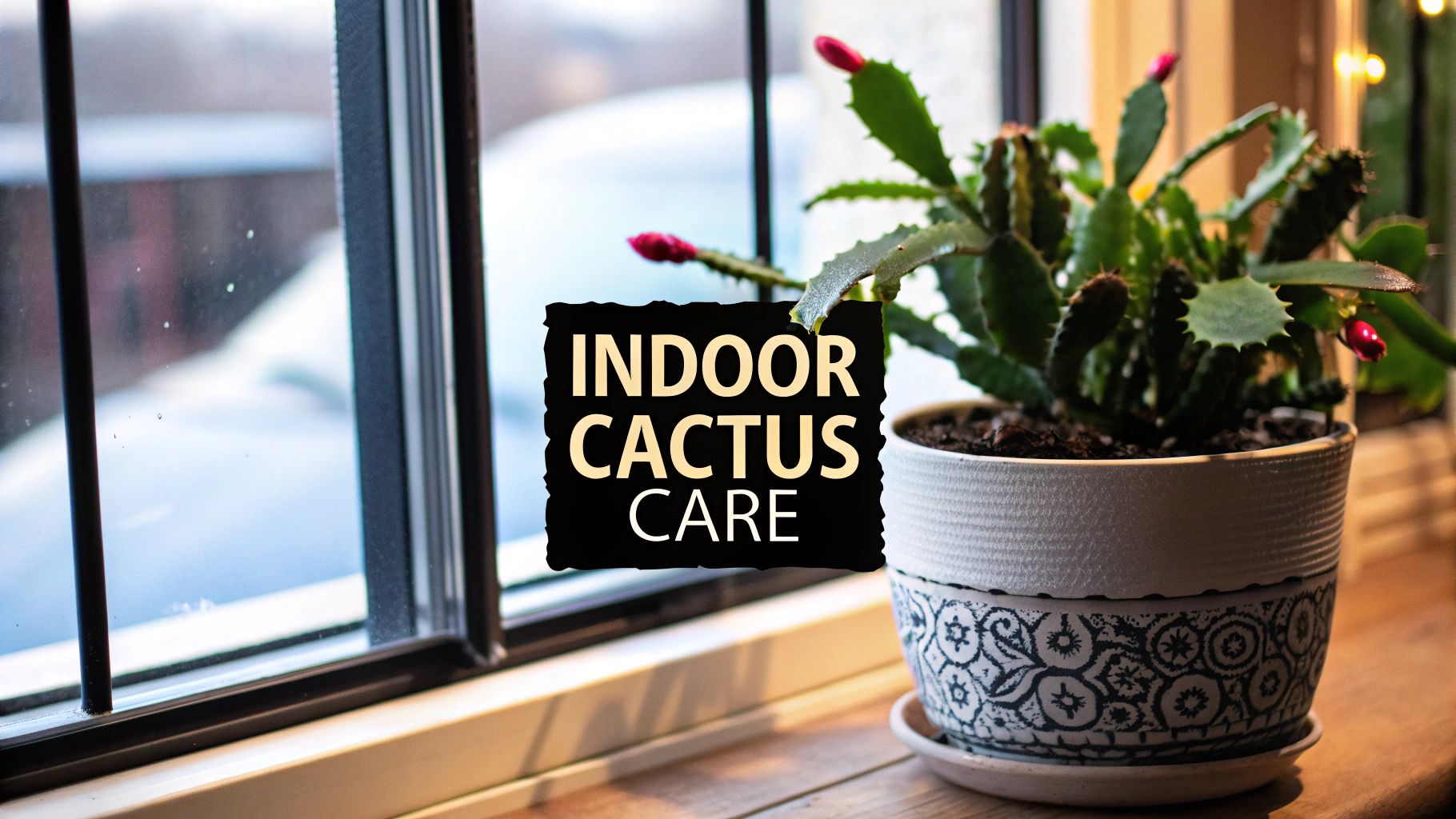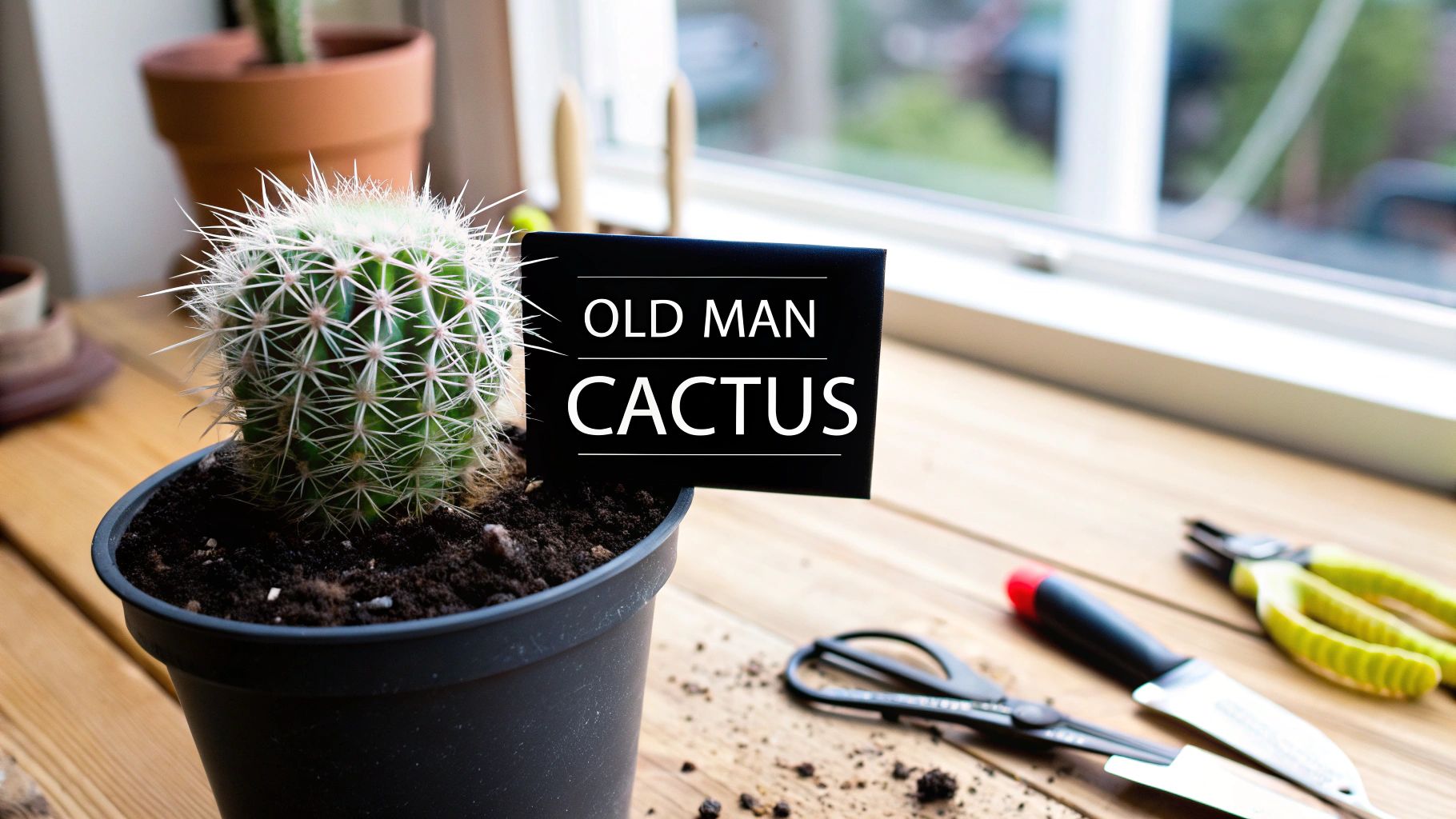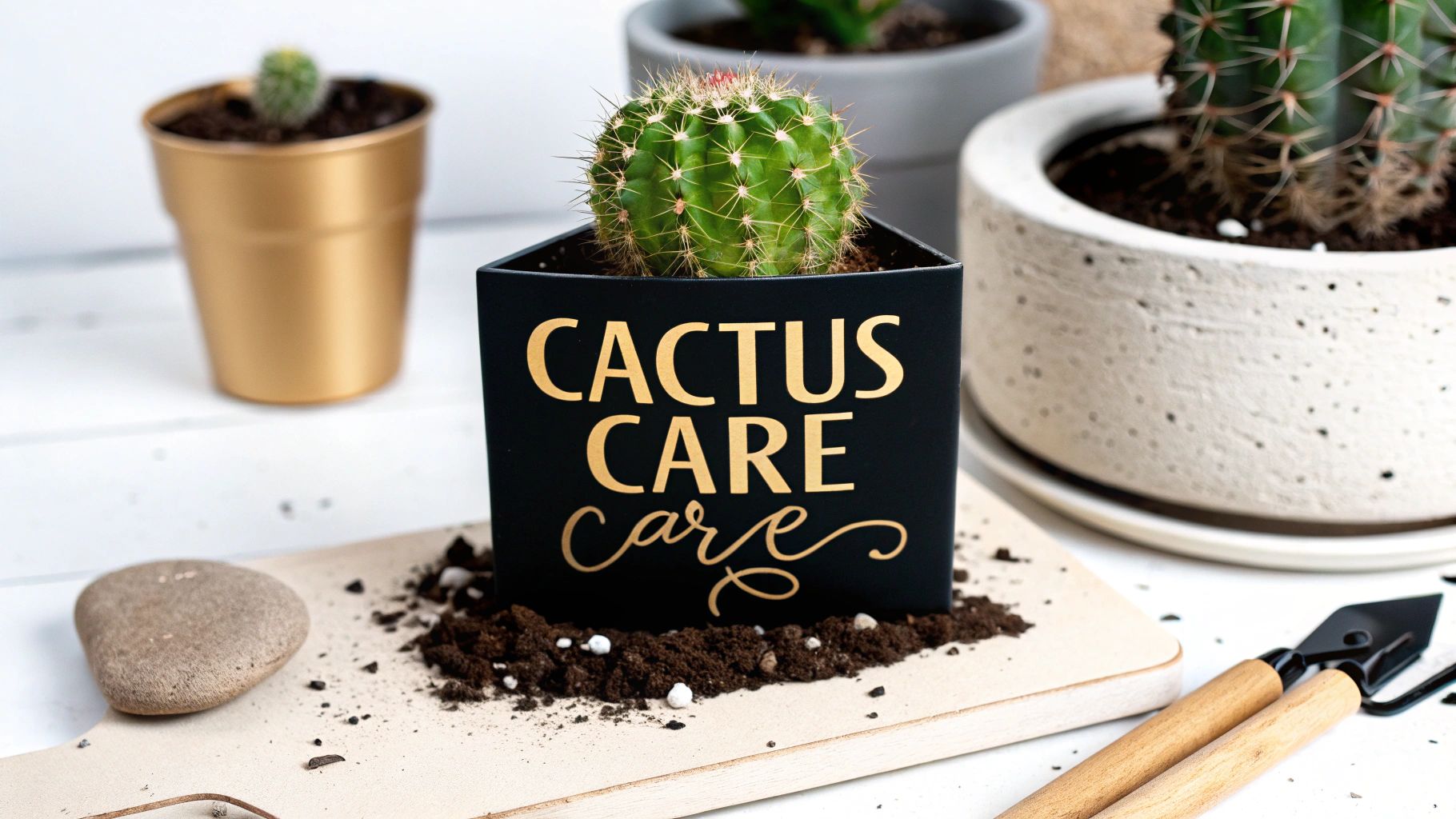Succulents are more than just low-maintenance houseplants; they're living sculptures. When thoughtfully arranged within a terrarium, they create captivating miniature worlds that bring a touch of nature indoors. However, many enthusiasts stick to the same basic formula: a simple glass bowl, some rocks, and a few common plants. It’s time to move beyond the expected and explore designs that truly stand out. This guide is your blueprint for creating unique and inspiring succulent terrarium ideas that push creative boundaries.
We will explore 8 distinct concepts that transform the traditional terrarium into a stunning piece of living art. From modern geometric designs and hanging macramé displays to intricate miniature landscapes and eco-friendly upcycled creations, each idea is a complete project guide. You'll find specific plant recommendations, material lists, and actionable layering techniques for building a healthy, self-contained ecosystem. Forget generic advice; this roundup provides the detailed insights you need to build a statement piece that not only reflects your personal style but also thrives for years to come. Whether you're an experienced gardener or a curious beginner, prepare to reinvent your indoor garden with these innovative designs.
1. Geometric Glass Terrarium
The geometric glass terrarium is a cornerstone of modern indoor gardening, blending horticultural science with architectural design. These containers, often shaped as pyramids, cubes, or complex dodecahedrons, feature clean lines and a minimalist aesthetic that transforms a simple succulent arrangement into a living sculpture. Their angular, multifaceted surfaces catch and refract light, creating a dynamic display that highlights the unique forms and colors of the plants within.

Popularized by design-forward movements like the Urban Jungle Bloggers, these terrariums are celebrated for their versatility. They serve as stunning centerpieces on coffee tables, add a touch of green to office desks, and complement industrial or contemporary home decor. The structured frame, typically made of brass, copper, or black-finished metal, provides a striking contrast to the organic shapes of the succulents.
Implementation and Plant Selection
To create a thriving geometric display, focus on plants with contrasting shapes that complement the container's angles.
- Tall & Spiky: Use Haworthia or Gasteria varieties to add vertical interest that draws the eye upward along the terrarium's lines.
- Rosettes: Echeverias like 'Lola' or 'Perle von Nurnberg' create a soft, central focal point.
- Spillers: A trailing succulent such as Sedum morganianum (Burro's Tail) can be planted near an opening to cascade elegantly over the edge.
Care and Maintenance Tips
Success with these succulent terrarium ideas hinges on proper care, especially concerning airflow and moisture. Since many geometric designs are partially open, they offer better ventilation than closed terrariums, which is ideal for drought-tolerant plants.
Expert Insight: The key to a healthy geometric terrarium is preventing moisture buildup. Always use a fast-draining cactus and succulent soil mix and ensure the container has a drainage hole or a deep layer of gravel to keep roots from sitting in water.
To keep your display pristine, rotate it quarterly for even sun exposure and clean the glass monthly with a diluted vinegar solution. For more detailed instructions on keeping your plants healthy, you can learn more about proper succulent care.
2. Air Plant Succulent Mix
The Air Plant Succulent Mix offers an innovative approach to terrarium design, combining soil-rooted succulents with epiphytic air plants (Tillandsia). This hybrid arrangement creates a dynamic, multi-layered ecosystem that showcases different growth habits in a single container. Since air plants absorb moisture and nutrients from the air, they require no soil, allowing for creative placements on driftwood, crystals, or suspended elements alongside traditional succulents.
This style has been popularized by plant specialists like Airplantman and design influencers who celebrate its low-maintenance and artistic potential. These unique succulent terrarium ideas merge textures and forms, contrasting the architectural leaves of a Tillandsia xerographica with the soft rosettes of an Echeveria. The result is a visually complex display that requires minimal soil, making it ideal for glass containers where root space is limited.
Implementation and Plant Selection
Success with this mix lies in balancing the distinct needs of both plant types. Choose species that thrive in similar light conditions to create a cohesive and healthy environment.
- Air Plants: Mount Tillandsia ionantha or Tillandsia caput-medusae on small pieces of cork bark or decorative stones to elevate them above the soil.
- Rooted Succulents: Use low-growing, drought-tolerant varieties like Sedum or compact Haworthia that won't overshadow the air plants.
- Focal Point: A larger, sculptural air plant like Tillandsia xerographica can serve as a stunning, soil-free centerpiece.
Care and Maintenance Tips
The primary challenge is watering: succulents need infrequent soil watering, while air plants require misting or soaking. This separation of needs is what makes the design so effective.
Expert Insight: Never let your air plants sit in soggy soil. Position them on elevated surfaces within the terrarium to ensure they receive ample air circulation and can dry completely after misting, preventing rot.
Mist air plants 1-2 times per week and soak them in room-temperature water for 20 minutes every month. Water the succulents only when the soil is completely dry. To find succulents that pair well with this low-water environment, you can explore some of the easiest succulents to grow indoors.
3. Succulent Sand Terrarium
The succulent sand terrarium is a visually striking design that captures the essence of arid desert landscapes. This style uses stratified layers of colored sand to create a geological cross-section effect, turning the container into a miniature diorama. The focus is on visual depth and texture, with layers of white, tan, red, or black sand forming a dramatic backdrop for rugged, drought-tolerant plants.
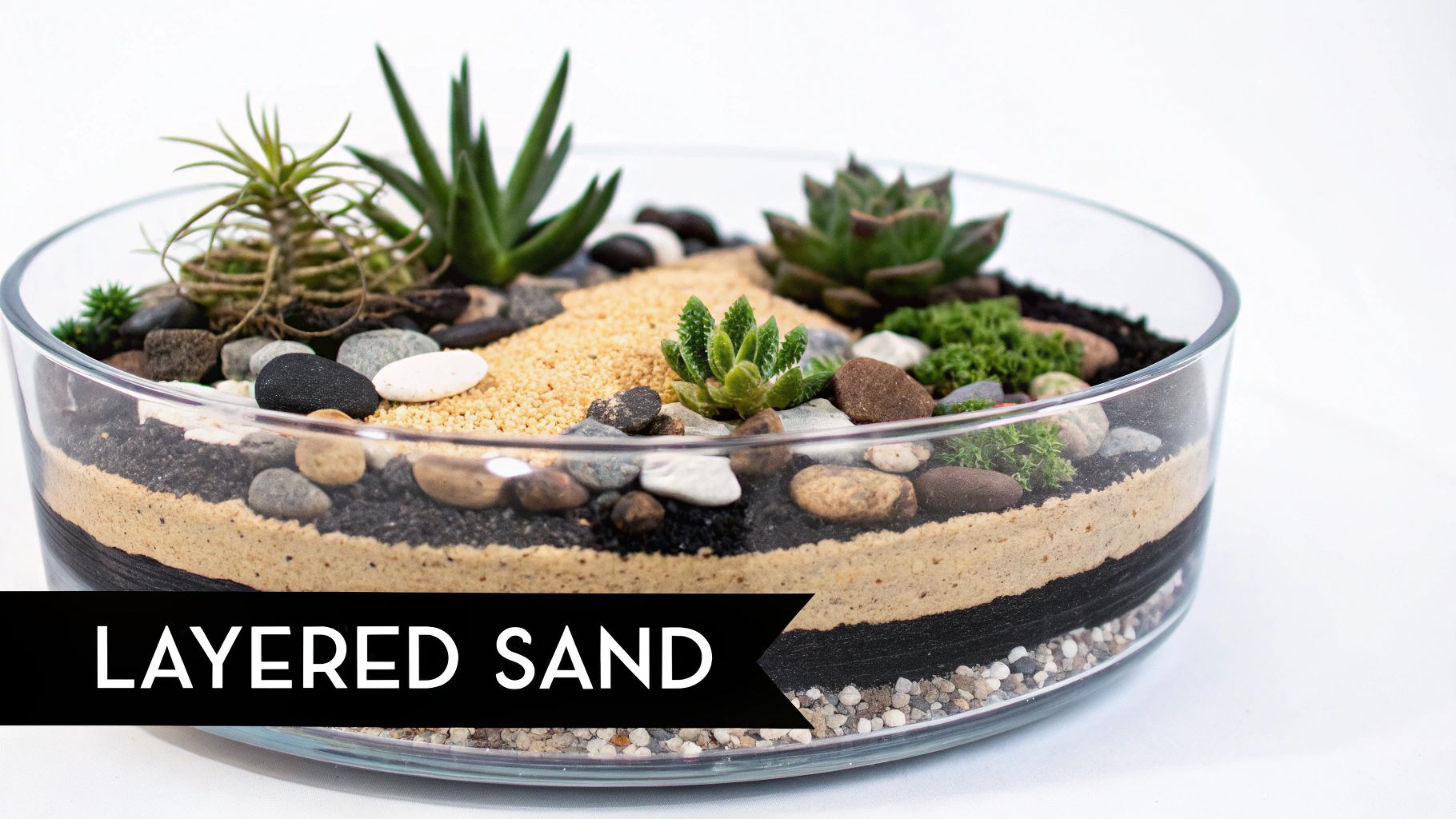
Popularized by home décor retailers and DIY communities on platforms like Pinterest, these terrariums serve as captivating artistic statements. They are perfect for anyone looking to create a low-water garden with a strong aesthetic narrative. The distinct layers mimic natural sediment formations, highlighting the resilience and architectural beauty of desert flora. This approach transforms a simple planting into a piece of botanical art.
Implementation and Plant Selection
Creating a successful sand art terrarium requires careful layering and plant placement to preserve the design.
- Geological Forms: Use Lithops (Living Stones) or Pleiospilos nelii (Split Rock) to blend seamlessly with a rocky, sandy base.
- Textural Contrast: A fuzzy Echeveria setosa or a sharp, architectural Agave victoriae-reginae adds a contrasting texture that stands out against the smooth sand.
- Focal Point: Choose a single, striking specimen like a Mammillaria cactus to act as the central anchor of your desert scene.
Care and Maintenance Tips
The primary challenge with sand terrariums is maintaining the integrity of the layers while providing adequate water. The sand itself offers poor nutrition and aeration, making the underlying soil structure critical.
Expert Insight: To prevent the sand layers from mixing during watering, create a "false bottom" by adding a thin layer of fine gravel and activated charcoal beneath the sand. Then, use a small spoon to carve out a pocket for each plant, filling it with a proper soil mix before inserting the succulent.
Water sparingly using a squeeze bottle with a narrow tip, directing the water directly at the base of the plant. This targeted approach minimizes disturbance to the sand design. To ensure your succulents get the right nutrients and drainage, you can discover more about the ideal cactus and succulent soil composition.
4. Hanging Macramé Succulent Planter
The hanging macramé succulent planter brings a touch of bohemian elegance to indoor gardening, merging the timeless craft of fiber art with horticulture. This design suspends succulents in hand-knotted hangers, creating an ethereal, floating display that saves space and adds vertical interest. These planters typically cradle glass globes, ceramic bowls, or wooden vessels, with the intricate knots of cotton or jute cord providing a soft, textural contrast to the sleek containers.
Popularized by the 1970s design revival and championed by contemporary brands like Free People and Anthropologie, these hanging succulent terrarium ideas have become a staple in modern boho and Scandinavian decor. They are perfect for brightening up empty corners, framing windows, or creating a tiered garden effect when hung at varying heights. The artisanal feel of macramé adds warmth and personality to any room.
Implementation and Plant Selection
To create a visually striking macramé planter, choose trailing succulents that will spill over the container’s edge, enhancing the cascading effect of the hanger.
- Trailing Varieties: Senecio rowleyanus (String of Pearls) and Senecio 'String of Dolphins' are excellent choices, as their delicate strands drape beautifully through the macramé cords.
- Heart-Shaped Leaves: Ceropegia woodii (String of Hearts) adds a romantic, whimsical touch with its trailing vines and distinctive foliage.
- Dense Spillers: Sedum morganianum (Burro's Tail) provides a lush, full appearance with its thick, overlapping leaves that create a substantial cascade.
Care and Maintenance Tips
The key to a thriving hanging macramé terrarium is balancing light, air, and water. Their elevated position often provides excellent air circulation, which is beneficial for succulents. However, watering requires more care than a tabletop display.
Expert Insight: Always remove the plant vessel from its macramé holder before watering. This prevents the rope from absorbing excess moisture, which can lead to rot or mildew and damage the fibers over time. Allow the soil to dry completely before returning it to the hanger.
Choose a durable, high-quality cotton cord (at least 4-5mm) to ensure your planter can safely support the weight of the pot and soil. For beginners, starting with simple square knots and using a sturdy wooden ring or dowel for support is a great way to enter the world of macramé plant design.
5. Aquatic Succulent Terrarium (Water Features)
The aquatic succulent terrarium introduces an unexpected element of motion and sound, merging the arid world of succulents with the soothing presence of a water feature. These innovative designs create a hybrid ecosystem where drought-tolerant plants thrive alongside miniature ponds, streams, or waterfalls. The concept hinges on intelligent separation, using raised planting beds and moisture barriers to protect succulent roots from excess water while creating a stunning, multi-sensory display.
This approach transforms a static arrangement into a dynamic, living art piece. Often seen in high-end interior designs and botanical art installations, these succulent terrarium ideas challenge traditional horticultural boundaries. The contrast between the still, sculptural forms of the succulents and the gentle flow of water creates a focal point that is both visually captivating and audibly calming, reminiscent of a natural oasis.
Implementation and Plant Selection
Success requires meticulous separation of the wet and dry zones. Build raised sections for planting succulents well above the water line, using waterproof barriers like pond liner or aquarium-grade silicone to seal the planting area.
- Moisture-Tolerant Edge Plants: Near the water's edge, but not in the saturated zone, consider hardier succulents like Sedum or Sempervivum that can handle slightly higher humidity.
- Elevated Specimens: Place delicate rosettes such as Echeveria or cacti on the highest, driest points of the landscape to prevent any risk of root rot.
- Aquatic Plants: Add true aquatic plants like Marimo Moss Balls or Dwarf Anubias directly into the water feature to complete the ecosystem.
Care and Maintenance Tips
Maintaining this dual environment requires careful attention to both the plants and the water. The primary goal is to prevent the dry soil from becoming waterlogged while keeping the water feature clean and functional.
Expert Insight: The key to a long-lasting aquatic terrarium is creating two completely separate drainage systems. Your succulent planting area must drain away from the water feature, while the water feature itself requires a small, low-flow pump and filter to stay clear and healthy.
Use a submersible mini-pump to circulate the water, preventing stagnation. Check water levels weekly, topping off with distilled water to avoid mineral buildup on the glass. Ensure the succulents are watered independently and only when their soil is completely dry to the touch.
6. Miniature Landscape Narrative Terrarium
The miniature landscape narrative terrarium transforms a simple plant arrangement into a tiny, living diorama. This highly creative approach uses succulents as the botanical foundation for storytelling, incorporating miniature figurines, pathways, and props to build intricate scenes. These displays are less about horticulture alone and more about world-building, allowing creators to design everything from enchanted fairy gardens to serene desert villages or rugged mountain retreats.
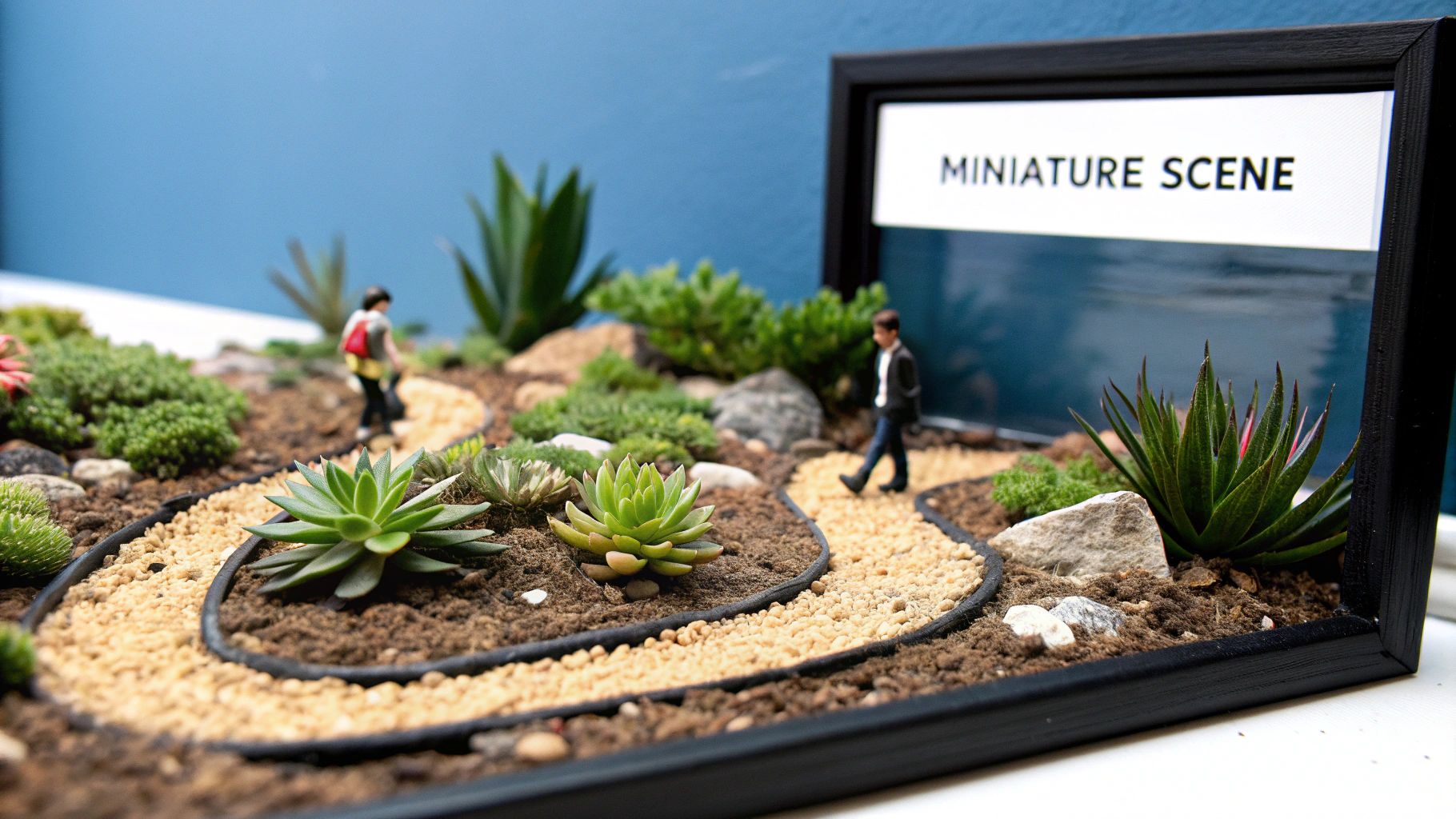
Driven by the fairy garden movement and amplified by creative communities on Etsy, Pinterest, and Instagram, these narrative terrariums have become a popular form of botanical art. They invite viewers to look closer and discover a hidden story within the foliage. This style is perfect for those who enjoy crafting and model-making, offering a unique way to combine a love for plants with imaginative expression and design.
Implementation and Plant Selection
To build a compelling narrative, select succulents that function as landscape elements to create scale and depth.
- Trees & Shrubs: Use Crassula ovata 'Gollum' (Gollum Jade) or Portulacaria afra (Elephant Bush) to mimic the look of miniature trees and shrubbery.
- Groundcover: Spreading varieties like Sedum dasyphyllum 'Minor' or Sedum album can create the effect of a lush lawn or mossy ground.
- Architectural Features: Upright succulents such as Haworthiopsis attenuata (Zebra Plant) can represent alien towers or dramatic rock formations in your scene.
Care and Maintenance Tips
Maintaining a narrative terrarium requires careful attention to both the plants and the props. The goal is to preserve the integrity of your miniature scene while ensuring the succulents thrive.
Expert Insight: Before you plant, sketch out your scene. Planning the foreground, mid-ground, and background will help you place succulents and miniatures effectively, creating a sense of depth and perspective. Secure small props with a non-toxic adhesive to prevent them from shifting during watering.
Water gently at the soil level with a squirt bottle or small watering can to avoid displacing decorative elements. To further enhance your miniature landscape narrative, consider learning how to make model trees from scratch to add diverse 'flora' elements to your terrarium scene. Rotate the display quarterly to provide even light and consider swapping out seasonal props to keep the story fresh and engaging.
7. Vertical Living Wall Succulent Terrarium
The vertical living wall transforms the concept of a terrarium from a tabletop object into a large-scale, architectural feature. This innovative approach utilizes wall-mounted frames, modular pockets, or specialized shelving to create a "living painting" made of succulents. It's a space-efficient solution that brings a dramatic and textured green element to urban apartments, corporate offices, or even outdoor patios, turning a blank wall into a breathtaking ecosystem.
These installations are increasingly popular in commercial spaces like high-end hotels and design studios, where they serve as dynamic, living art. The beauty of this succulent terrarium idea is its scalability; it can be a small, framed piece or cover an entire wall. By arranging plants in patterns or color gradients, a vertical garden becomes a powerful design statement that merges nature with interior decor.
Implementation and Plant Selection
Success with a living wall depends on choosing the right plants and providing a suitable structure. Lightweight, shallow-rooted succulents are essential to prevent the display from becoming too heavy.
- Rosettes: Compact Echeveria and Sempervivum (Hens and Chicks) varieties are perfect for creating dense, colorful clusters.
- Fillers: Low-growing Sedum species, like 'Angelina' or 'Blue Spruce', will spread to fill in gaps and add fine texture.
- Spillers: For a softer edge, place trailing plants like Senecio rowleyanus (String of Pearls) or Othonna capensis (Little Pickles) along the bottom.
Care and Maintenance Tips
Maintaining a vertical succulent garden requires a different approach than a standard terrarium, primarily concerning watering and structural integrity. The upward orientation means gravity affects water distribution and soil stability.
Expert Insight: For large-scale installations, an integrated drip irrigation system is a game-changer. It provides consistent, controlled moisture directly to the roots without oversaturating the soil, preventing rot and soil erosion. For smaller frames, water carefully with a squirt bottle at the base of each plant.
Ensure the wall can support the weight of the final installation, including soil, plants, and water. For very large projects, consulting a structural engineer is highly recommended. Position the wall where it will receive at least six hours of bright, indirect sunlight to keep the succulents compact and vibrant.
8. Recycled Container Terrarium (Upcycled Materials)
The recycled container terrarium champions sustainability and creativity, transforming everyday objects into unique, eco-conscious succulent displays. This approach embraces resourcefulness by repurposing items like vintage glass jars, old teacups, light bulbs, or even hollowed-out wooden boxes. The result is a one-of-a-kind arrangement that tells a story, adding character and a personal touch that mass-produced containers cannot replicate.
Driven by the DIY and sustainability movements popularized on platforms like Pinterest and Instagram, these upcycled terrarium ideas celebrate imperfection and ingenuity. A chipped teacup becomes a charming home for a sempervivum, while a collection of old mason jars can form a rustic, cohesive display. This method not only reduces waste but also provides an accessible entry point for beginners looking to create a beautiful terrarium without a significant initial investment.
Implementation and Plant Selection
Creating a thriving upcycled display involves matching the plant to the container's unique constraints and aesthetic.
- Small Containers (Teacups, Light Bulbs): Tiny succulents like Sedum dasyphyllum 'Minor' or small Sempervivum chicks are perfect for these limited spaces.
- Medium Containers (Glass Jars, Tin Cans): Use a mix of textures. Pair a central Echeveria with a trailing Senecio rowleyanus (String of Pearls) to spill over the side.
- Large Containers (Wine Bottles, Wooden Boxes): Create a miniature landscape with taller Crassula ovata (Jade Plant) varieties alongside mounding sedums.
Care and Maintenance Tips
Success with recycled succulent terrarium ideas depends on adapting to the container's limitations, especially regarding drainage. Since most upcycled items lack pre-drilled holes, creating a proper environment is critical for plant health.
Expert Insight: When working with non-traditional containers, a robust drainage layer is non-negotiable. Add a deep base of pebbles or small rocks, followed by a layer of activated charcoal to absorb impurities and prevent root rot before adding your soil mix.
Before planting, thoroughly clean and sterilize any repurposed container to remove potential contaminants. If you are using a delicate vintage piece, consider using a flexible plastic liner to protect both the container and the plant's roots from direct contact and moisture damage.
8 Succulent Terrarium Ideas Compared
| Design | Implementation Complexity 🔄 | Resource Requirements ⚡ | Expected Outcomes 📊 | Ideal Use Cases 💡 | Key Advantages ⭐ |
|---|---|---|---|---|---|
| Geometric Glass Terrarium | Moderate — Easy to Intermediate; fragile assembly and cleaning 🔄 | Moderate–High — quality glass, metal accents; $30–$150+ ⚡ | High — striking modern display; excellent light transmission but limited planting space 📊 | Minimalist/tabletop décor, shelf displays, photo styling 💡 | ⭐⭐⭐⭐ — Very decorative, great visibility for plant health |
| Air Plant Succulent Mix | Low — simple assembly; low ongoing effort 🔄 | Low — inexpensive air plants, cork/wood bases; minimal soil ⚡ | Medium — low-maintenance, textured aesthetic; humidity balance needed 📊 | Beginner setups, hanging displays, low-maintenance homes 💡 | ⭐⭐⭐ — Very low maintenance, cost-effective, versatile |
| Succulent Sand Terrarium | Low — quick assembly; gentle watering to protect layers 🔄 | Low — colored sand, shallow dish, succulents; inexpensive ⚡ | Medium — dramatic layered look; may need occasional rebuild and added drainage 📊 | DIY projects, classroom demos, quick décor pieces 💡 | ⭐⭐⭐ — Fast to make, visually impactful, low cost |
| Hanging Macramé Succulent Planter | Low–Moderate — knotting skills and secure installation 🔄 | Low — cord, small pots or globes, anchors; under $20 typical ⚡ | Medium — adds vertical interest; easy access for care but weight limits 📊 | Small-space vertical accents, bohemian interiors, DIY gifts 💡 | ⭐⭐⭐ — Space-saving, customizable, tactile aesthetic |
| Aquatic Succulent Terrarium (Water Features) | High — advanced waterproofing, electrical and pump integration 🔄 | High — pumps, LEDs, waterproofing materials; $150–$500+ ⚡ | High — multi-sensory focal point; complex maintenance and algae risk 📊 | High-end interiors, showrooms, educational/interactive displays 💡 | ⭐⭐⭐⭐ — Dramatic movement/sound, supports diverse ecosystems |
| Miniature Landscape Narrative Terrarium | Moderate–High — time-consuming design and precise placement 🔄 | Medium — many miniatures, varied succulents; sourcing components ⚡ | High — highly engaging, social-media friendly, very customizable 📊 | Workshops, gifts, storytelling displays, creative studios 💡 | ⭐⭐⭐⭐ — Strong engagement, endless customization, artistic |
| Vertical Living Wall Succulent Terrarium | High — structural mounting, irrigation, weight calculations 🔄 | High — frames, irrigation/drip systems, anchors; professional install possible ⚡ | High — large visual impact, space-efficient but requires maintenance 📊 | Offices, restaurants, large residential walls, public installations 💡 | ⭐⭐⭐⭐ — Maximizes vertical space, modular and scalable |
| Recycled Container Terrarium (Upcycled Materials) | Low–Moderate — creative drainage solutions and cleaning 🔄 | Low — salvaged containers; minimal cost (often free) ⚡ | Medium — unique, sustainable displays; may need custom solutions for drainage 📊 | Eco-conscious DIY, budget projects, community workshops 💡 | ⭐⭐⭐ — Sustainable, inexpensive, one-of-a-kind aesthetic |
Start Building Your Miniature World Today
You've explored a diverse landscape of succulent terrarium ideas, from the modern elegance of geometric glass designs to the eco-conscious charm of upcycled containers. We've journeyed through minimalist sand art creations, whimsical miniature narratives, and even dynamic vertical living walls. Each concept offers a unique canvas for your creativity, proving that a succulent terrarium is far more than just a planter; it's a living sculpture, a personal ecosystem, and a testament to the beauty of nature condensed into a single, stunning display.
The true magic of these projects lies in their versatility. Whether you are an interior decorator seeking a bold statement piece or a home gardener looking for a new creative outlet, the right design is waiting for you. The key takeaway is that successful terrarium building is a blend of artistic vision and horticultural science. Proper drainage, appropriate plant selection, and thoughtful composition are the foundational pillars that allow your artistic expression to flourish.
Key Principles for Success
As you move from inspiration to creation, remember these core principles that underpin every beautiful and long-lasting succulent terrarium:
- Drainage is Non-Negotiable: Succulents despise "wet feet." A foundational layer of pebbles or gravel is essential to prevent root rot, which is the most common reason terrariums fail.
- Substrate Matters: Use a specialized, well-draining cactus or succulent soil mix. This ensures that water drains quickly and roots get the aeration they need to thrive.
- Plant Compatibility is Crucial: Group succulents with similar light and water requirements. Pairing a sun-loving Echeveria with a shade-tolerant Haworthia can lead to one plant thriving while the other suffers.
- Embrace Open Systems: While closed terrariums are beautiful for humidity-loving plants, succulents need air circulation to prevent fungal growth. Always opt for a container with an opening to ensure a healthy environment.
Your Next Creative Steps
Feeling inspired? The next step is to choose the project that speaks to you and gather your materials. Don't be afraid to mix and match elements from different succulent terrarium ideas to create something uniquely yours. Perhaps you'll combine the hanging macramé concept with a recycled glass jar, or add a miniature water feature to your geometric terrarium. The possibilities are truly endless.
As you prepare to embark on your terrarium journey, you can find inspiration and practical steps in this detailed guide on how to create a terrarium. This resource can help you solidify the fundamental techniques, ensuring your first or next project is a resounding success. By starting today, you are not just decorating a space; you are cultivating a miniature world, a small piece of living art that will grow and evolve with you.
Ready to bring your vision to life with vibrant, healthy plants? The Cactus Outlet offers a vast, hand-selected collection of premium succulents and cacti perfect for any terrarium project you can imagine. Explore our online nursery at The Cactus Outlet to find the perfect specimens to build your miniature masterpiece.


